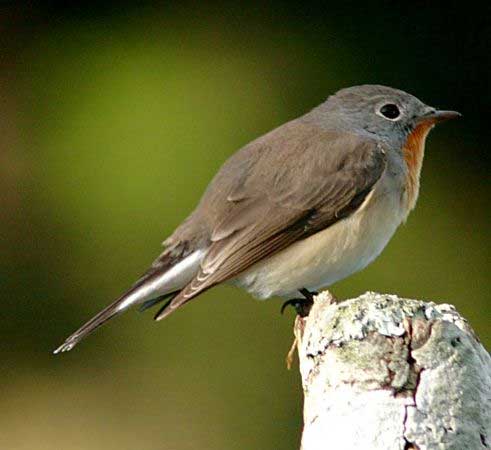
Ficedula parva (*)
Superregnum: Eukaryota
Cladus: Unikonta
Cladus: Opisthokonta
Cladus: Holozoa
Regnum: Animalia
Subregnum: Eumetazoa
Cladus: Bilateria
Cladus: Nephrozoa
Superphylum: Deuterostomia
Phylum: Chordata
Subphylum: Vertebrata
Infraphylum: Gnathostomata
Megaclassis: Osteichthyes
Cladus: Sarcopterygii
Cladus: Rhipidistia
Cladus: Tetrapodomorpha
Cladus: Eotetrapodiformes
Cladus: Elpistostegalia
Superclassis: Tetrapoda
Cladus: Reptiliomorpha
Cladus: Amniota
Classis: Reptilia
Cladus: Eureptilia
Cladus: Romeriida
Subclassis: Diapsida
Cladus: Sauria
Infraclassis: Archosauromorpha
Cladus: Crurotarsi
Divisio: Archosauria
Cladus: Avemetatarsalia
Cladus: Ornithodira
Subtaxon: Dinosauromorpha
Cladus: Dinosauriformes
Cladus: Dracohors
Cladus: Dinosauria
Ordo: Saurischia
Cladus: Eusaurischia
Cladus: Theropoda
Cladus: Neotheropoda
Cladus: Averostra
Cladus: Tetanurae
Cladus: Avetheropoda
Cladus: Coelurosauria
Cladus: Tyrannoraptora
Cladus: Maniraptoromorpha
Cladus: Maniraptoriformes
Cladus: Maniraptora
Cladus: Pennaraptora
Cladus: Paraves
Cladus: Eumaniraptora
Cladus: Avialae
Infraclassis: Aves
Cladus: Euavialae
Cladus: Avebrevicauda
Cladus: Pygostylia
Cladus: Ornithothoraces
Cladus: Euornithes
Cladus: Ornithuromorpha
Cladus: Ornithurae
Cladus: Carinatae
Parvclassis: Neornithes
Cohors: Neognathae
Cladus: Neoaves
Cladus: Telluraves
Cladus: Australaves
Ordo: Passeriformes
Subordo: Passeri
Infraordo: Passerida
Superfamilia: Muscicapoidea
Familia: Muscicapidae
Genus: Ficedula
Species: Ficedula parva
Name
Ficedula parva (Bechstein, 1792)
References
Kurzgefaszte gemeinnutzige Naturgeschichte des In- und Auslandes für Schulen und hauslichen Unterricht. 1: 531, note
Vernacular names
беларуская: Валасяніца малая
български: Червеногуша мухоловка
brezhoneg: Flouperig jave ruz
čeština: Lejsek malý
dansk: Lille Fluesnapper
Deutsch: Zwergschnäpper
English: Red-breasted Flycatcher
español: Papamoscas papirrojo
suomi: Pikkusieppo
français: Gobe-mouche nain
magyar: Kis légykapó
հայերեն: Ճանճորս փոքր
italiano: Pigliamosche pettirosso
日本語: オジロビタキ
lietuvių: Mažoji musinukė
latviešu: Mazais mušķērājs
Bahasa Melayu: Burung Sambar Api Bukit
Nederlands: Kleine vliegenvanger
norsk: Dvergfluesnapper
polski: Muchołówka mała
português: Papa-moscas-pequeno
русский: Малая мухоловка
slovenčina: Muchárik červenohrdlý
svenska: Mindre flugsnappare
Türkçe: Küçük sinekkapan
українська: Мухоловка мала
中文(繁體): 紅喉鶲
中文: 红喉姬鹟
The red-breasted flycatcher (Ficedula parva) is a small passerine bird in the Old World flycatcher family. It breeds in eastern Europe and across Central Asia and is migratory, wintering in south Asia. It is a regular passage migrant in western Europe, whereas the collared flycatcher which breeds further east is rare. This is because of the different migration direction. The Asian species Ficedula albicilla, previously considered a subspecies of the red-breasted flycatcher, has the red throat surrounded by grey and a different song. It is usually now separated as the taiga flycatcher (Pallas, 1811).
The breeding male of this small 11–12 cm long flycatcher is mainly brown above and white below, with a grey head and orange throat. The bill is black and has the broad but pointed shape typical of aerial insectivores. As well as taking insects in flight, this species hunts caterpillars amongst the oak foliage, and will take berries. The base of the outertail feather is white and the tail is often flicked upwards as they perch looking out for insect prey which are caught on the wing or sometimes from the ground. In winter they are mostly silent but have a typical chip-chip-chr-rrr flycatcher call. In their breeding season, the song consists of melodious whistles, like that of the European pied flycatcher.
Non-breeding males, females and juveniles have brown heads and lack the throat collar, but are easily distinguished from other Ficedula flycatchers on size and the wheatear-like tail pattern, with an inverted dark T against the white tail sides.
They are found mainly deciduous woodlands, especially near water. They build an open nest in a tree hole or similar recess. 4–7 eggs are laid.
Studies on their spring arrivals to the breeding quarters in Poland from 1973–2002 show that males are returning earlier with increasing temperatures.[2]
The genus name is from Latin and refers to a small fig-eating bird (ficus, "fig") supposed to change into the blackcap in winter. The specific parva is Latin for "small".[3]
References
BirdLife International. (2018). "Ficedula parva". IUCN Red List of Threatened Species. 2018: e.T22735909A132037161. doi:10.2305/IUCN.UK.2018-2.RLTS.T22735909A132037161.en. Retrieved 10 October 2021.
Cezary Mitrus; Tim H. Sparks & Piotr Tryjanowski (2005). "First evidence of phenological change in a transcontinental migrant overwintering in the Indian sub-continent: the Red-breasted Flycatcher Ficedula parva" (PDF). Ornis Fennica. 82: 13–19. Archived from the original (PDF) on 2007-07-19.
Jobling, James A. (2010). The Helm Dictionary of Scientific Bird Names. London, United Kingdom: Christopher Helm. pp. 167, 293. ISBN 978-1-4081-2501-4..
Retrieved from "http://en.wikipedia.org/"
All text is available under the terms of the GNU Free Documentation License

